Cyberpunk in Asia: Reflections on Dystopia in a Time of Coronavirus
Virtual exhibition created by the students in "English 217: Cyberpunk in Asia" taught by Jerrine Tan, Visiting Lecturer in Global Anglophone Literature, Spring 2020
In collaboration with Ellen Alvord
Designed and edited by Nina Frank
mh_1973_211_i_b_rii_v1_01-hpr_0_0.jpg

Laura Shea - VIEW OBJECT DETAILS
INTRODUCTION
In my English course titled, "Cyberpunk in Asia," we examine why the modern genre of cyberpunk dystopias has often been associated with Asian cities, neon signs, and crowded bustling streets. Viewing films such as Blade Runner and reading novels including Do Androids Dream of Electric Sheep, we interrogate how historical and economic forces have shaped the way the future is imagined and why the place of that reckoning resonates with Asia today. Given that visual imagery is central to the themes of our course—which even has its own Instagram account—it seemed natural to collaborate with the Art Museum on campus.
Due to the unexpected circumstances of COVID-19, we were not able to visit the Museum in person, so instead, I collaborated with Museum staff to plan a two-part remote museum activity for my students. The first involved a close-looking activity with four artworks from the MHCAM collection selected for the way they resonated with our course themes, including works by Wayne Thiebaud, Michael Jacobson-Hardy, Livia Corona, and Jane Hammond. Students studied the images online, shared responses, and then reflected on each others' insights. I highlight their astute observations in two video conversations (part I and part II) with Ellen Alvord, as part of the MHCAM in Conversation series.
I titled the second remote assignment "Pick One; Recommend One" and gave them more autonomy to select their own images. Students were given access to the Five College museum collections database and told to select an artwork that reflected the theme "Cyberpunk in Asia" or "Present Dystopias," as a way to think about our present moment. They were to write a 100-word label for their selected piece, offering description, analysis, and explanation on how it related to either theme. They then had to recommend a complementary piece of artwork. This could be from the internet, from Instagram, or a piece of art of their own creation such as a photograph, haiku, short poem, or drawing, for which they would also add a short write-up explaining how this piece connects to the first.
I was impressed by their insightful analyses and amazed at how creative and imaginative they were with the assignment. I hope you enjoy their selections and thoughtful commentary below.
Jerrine Tan
Visiting Lecturer in Global Anglophone
Literature (English Department)
The Cityscape and Vaporwave/Future Funk
by Haenah Lee '20
 Diorama Map Tokyo by Sohei Noshino (SCMA) is an impossible cityscape made up of collaged photographs of various elements: skyscrapers, pedestrians, boats, trains, and roads. While the artwork title suggests that this is a depiction of Tokyo, many of the elements appear to be repeated or spliced from another city entirely. Various buildings have a surrounding sky that looks out of place amongst the rest of the cityscape. This artwork encapsulates the cyberpunk city aesthetic because of its cramped busyness, which is filled to the brim with people and metal.
Diorama Map Tokyo by Sohei Noshino (SCMA) is an impossible cityscape made up of collaged photographs of various elements: skyscrapers, pedestrians, boats, trains, and roads. While the artwork title suggests that this is a depiction of Tokyo, many of the elements appear to be repeated or spliced from another city entirely. Various buildings have a surrounding sky that looks out of place amongst the rest of the cityscape. This artwork encapsulates the cyberpunk city aesthetic because of its cramped busyness, which is filled to the brim with people and metal.
 My recommended image is a typical representation of music covers for Vaporwave/Future Funk, with aesthetics rooted in gridlike cyberpunk abstraction. It is a subgenre of music that utilizes synths, pop drums, and other electrical instruments. Vaporwave/Future Funk often “samples” or takes inspiration from 1970’s and 1980’s music from both the west and Japan, which gives it a certain urban “nostalgia” and lighthearted atmosphere. These subgenres of music try to achieve what Diorama Map Tokyo accomplishes, an aural aesthetic of a cyberpunk-esque cityscape.
My recommended image is a typical representation of music covers for Vaporwave/Future Funk, with aesthetics rooted in gridlike cyberpunk abstraction. It is a subgenre of music that utilizes synths, pop drums, and other electrical instruments. Vaporwave/Future Funk often “samples” or takes inspiration from 1970’s and 1980’s music from both the west and Japan, which gives it a certain urban “nostalgia” and lighthearted atmosphere. These subgenres of music try to achieve what Diorama Map Tokyo accomplishes, an aural aesthetic of a cyberpunk-esque cityscape.
(Video) Games
by Allegra Wu '20
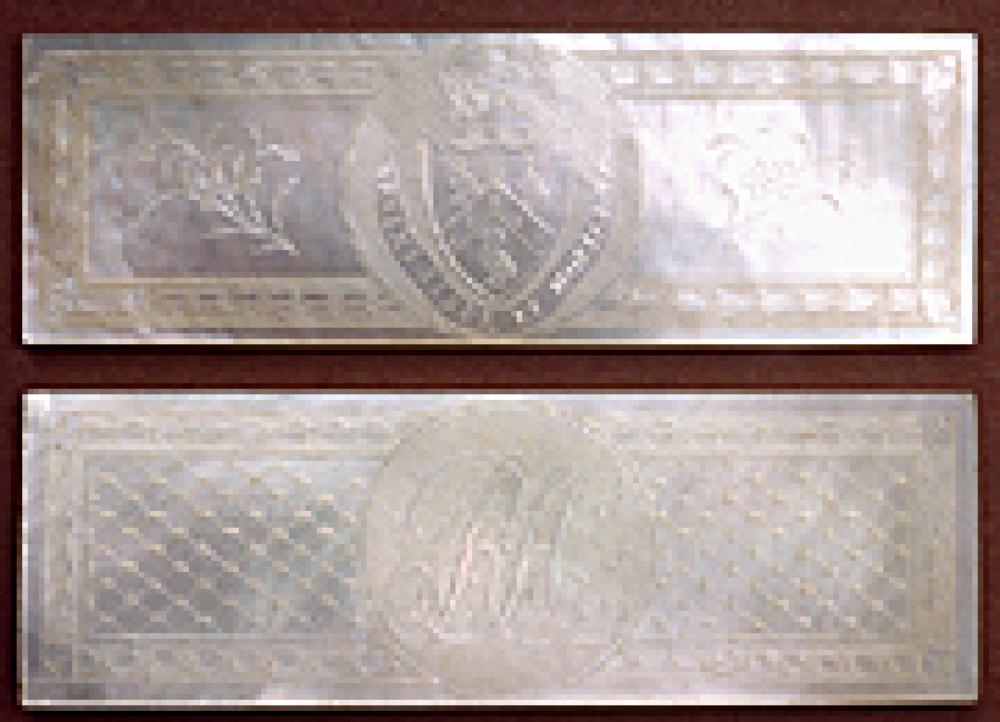 Made of mother-of-pearl, this object is a gaming counter (Historic Deerfield) that was used to keep score. Wealthy English families ordered these from Chinese artists, often with their family motto in script, which became a sort of rallying cry before a game began. This particular work is engraved with "VIXI LIBER ET MORIAR," which translates to "I have lived free, and will die so." Although it is a historic piece, I believe it serves as the inspiration for the intricate animations and graphics of video games in the Asian cyberpunk genre.
Made of mother-of-pearl, this object is a gaming counter (Historic Deerfield) that was used to keep score. Wealthy English families ordered these from Chinese artists, often with their family motto in script, which became a sort of rallying cry before a game began. This particular work is engraved with "VIXI LIBER ET MORIAR," which translates to "I have lived free, and will die so." Although it is a historic piece, I believe it serves as the inspiration for the intricate animations and graphics of video games in the Asian cyberpunk genre.
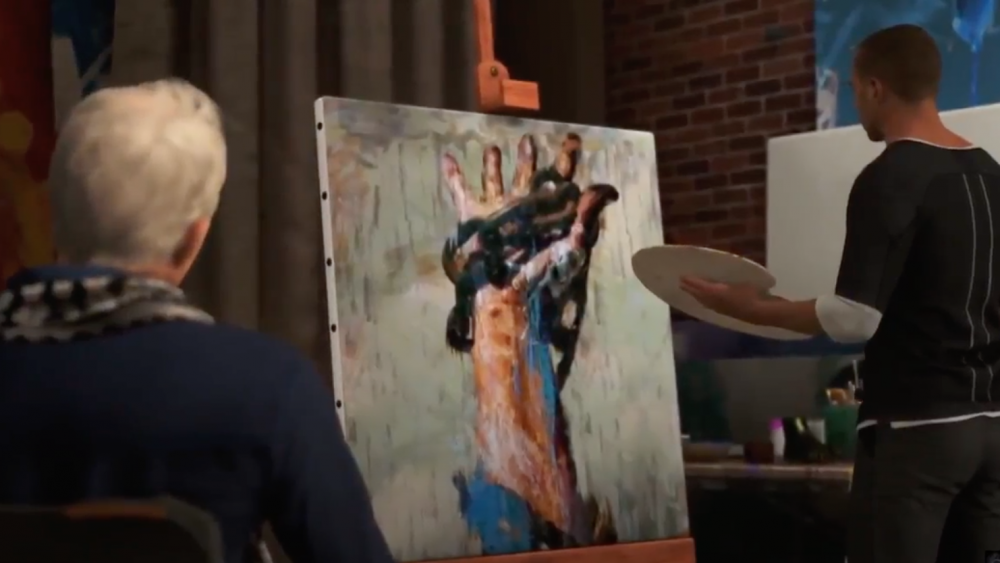 My recommended piece is a scene from the video game Detroit: Become Human where a player controls three androids, who are essentially slaves to their human owners with the goal of escaping bondage. The character on the right is an android named Markus, who takes care of a very famous elderly artist (left). The artist is one of the few humans who believes that androids are not just machines, but keys to a successful and bright future. When he asks Markus to paint something, Markus creates a perfect copy of the artist's work hanging in the studio. The artist then asks Markus to paint something original, allowing him to be creative, even though that is not in an android's program. This image depicts the moment that Markus realizes that despite being an android, he can live free, and would rather die so—connecting to the family motto from the gaming counter: "I have lived free and will die so."
My recommended piece is a scene from the video game Detroit: Become Human where a player controls three androids, who are essentially slaves to their human owners with the goal of escaping bondage. The character on the right is an android named Markus, who takes care of a very famous elderly artist (left). The artist is one of the few humans who believes that androids are not just machines, but keys to a successful and bright future. When he asks Markus to paint something, Markus creates a perfect copy of the artist's work hanging in the studio. The artist then asks Markus to paint something original, allowing him to be creative, even though that is not in an android's program. This image depicts the moment that Markus realizes that despite being an android, he can live free, and would rather die so—connecting to the family motto from the gaming counter: "I have lived free and will die so."
Human in Posthuman Colors
by Sarah Cavar '20
 In Ely Kim's digital print Paleo (Mead Art Museum), the artist reinvents a nineteenth-century artwork—Kikugawa Eizan’s Untitled (sumo parade)—by inverting colors in order to transform the traditional into the super-modern. The use of hyperpigmented and cyberpunk-associated colors, especially blue and green, carry the work from its sepia-origin to a near-posthuman space. Greenlit identical men sit meditatively accompanied by bright pink, unidentifiable organisms. The artist's use of color and shadow defamiliarize the figures. By inverting the colors of sumo parade, Kim suggests the "future" and "past" are not opposites, but mirror images produced by a consistent body of social relations and ethical concerns.
In Ely Kim's digital print Paleo (Mead Art Museum), the artist reinvents a nineteenth-century artwork—Kikugawa Eizan’s Untitled (sumo parade)—by inverting colors in order to transform the traditional into the super-modern. The use of hyperpigmented and cyberpunk-associated colors, especially blue and green, carry the work from its sepia-origin to a near-posthuman space. Greenlit identical men sit meditatively accompanied by bright pink, unidentifiable organisms. The artist's use of color and shadow defamiliarize the figures. By inverting the colors of sumo parade, Kim suggests the "future" and "past" are not opposites, but mirror images produced by a consistent body of social relations and ethical concerns.
 My recommended piece is Lace Shell (2016) by Lisa Wright. A heavy figure stands head bowed against a black background, with a black mask covering all but their eyes. The figure appears to be clothed but is covered entirely in glowing green lacework that looks like computer static. The lace covering the black mask contrasts with their eyes, which are looking at something out of frame. Like Ely Kim, Wright defamiliarizes the human body, taking an antiquated medium (lace) and catapulting it to a glowing, green future. The green-covered bow in the figure's hair suggests simultaneous anachronism and futurism, reimagining the human form in posthuman hues.
My recommended piece is Lace Shell (2016) by Lisa Wright. A heavy figure stands head bowed against a black background, with a black mask covering all but their eyes. The figure appears to be clothed but is covered entirely in glowing green lacework that looks like computer static. The lace covering the black mask contrasts with their eyes, which are looking at something out of frame. Like Ely Kim, Wright defamiliarizes the human body, taking an antiquated medium (lace) and catapulting it to a glowing, green future. The green-covered bow in the figure's hair suggests simultaneous anachronism and futurism, reimagining the human form in posthuman hues.
Homes Devoid of Humans
by Jia Hong '20
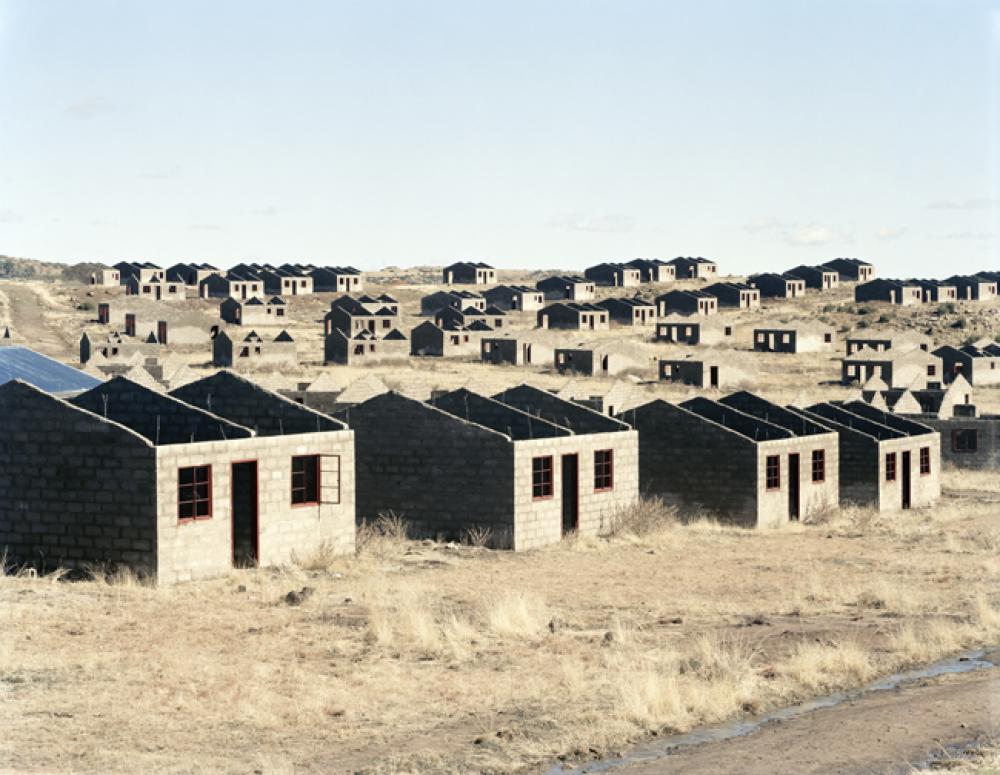 This photograph by David Goldblatt (UMCA) depicts an unfinished municipal housing project in the Lady Grey village of South Africa. The rows of identical clay houses are abandoned and are missing their rooftops and doors. The region looks arid and unforgiving and there are no traces of human habitation. The landscape's ghost-town like qualities remind me of a dystopia because it illustrates the great injustice done to the people of the Lady Grey village by the government—who failed them in seeing the project through. I'm thinking of the people that were meant to live in these homes. Now that we are in a time of quarantine—where do they go for shelter and security?
This photograph by David Goldblatt (UMCA) depicts an unfinished municipal housing project in the Lady Grey village of South Africa. The rows of identical clay houses are abandoned and are missing their rooftops and doors. The region looks arid and unforgiving and there are no traces of human habitation. The landscape's ghost-town like qualities remind me of a dystopia because it illustrates the great injustice done to the people of the Lady Grey village by the government—who failed them in seeing the project through. I'm thinking of the people that were meant to live in these homes. Now that we are in a time of quarantine—where do they go for shelter and security?
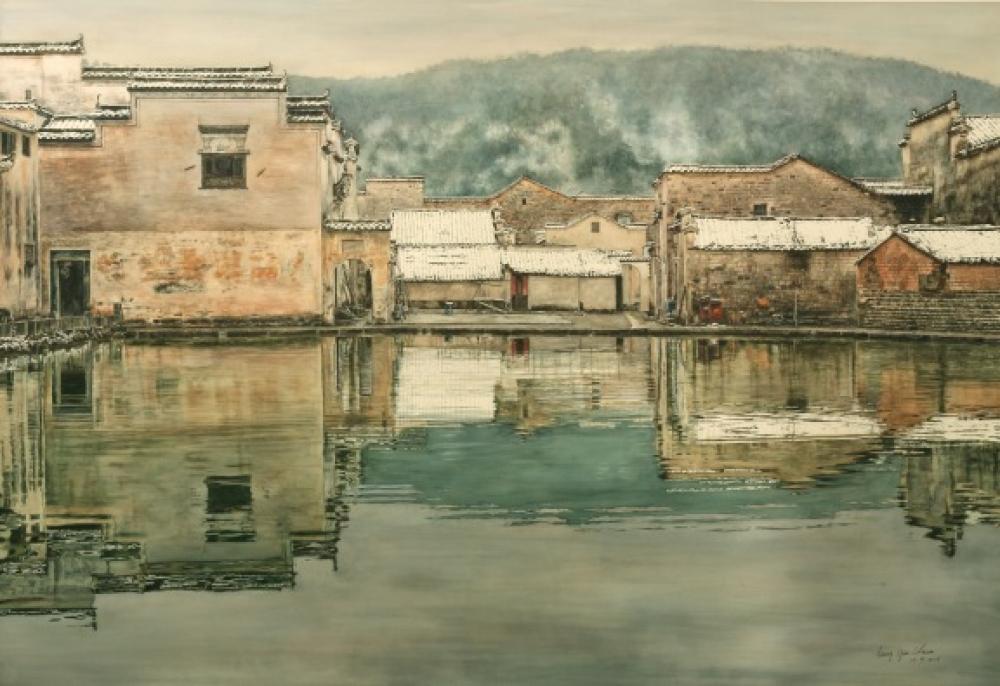 My recommended piece is a watercolor painting by Hong Kong based artist, Leung Yun Charm. The title, Serene Moment No. 3 is inspired by a local village in the inland Chinese province of Anhui. Charm’s work connects to the theme of “Present Dystopias” because it shows a similar stillness and eerie feeling as Goldblatt's photograph. Given that this painting is of a Chinese village, I'm reminded of the different struggles countries are facing while combating COVID-19. At the moment, China’s mandatory shelter-in-place is slowly being lifted, while the United States is ramping up restrictions. These artworks are like glimpses into the future for the rest of the world just starting to feel the effects of this pandemic.
My recommended piece is a watercolor painting by Hong Kong based artist, Leung Yun Charm. The title, Serene Moment No. 3 is inspired by a local village in the inland Chinese province of Anhui. Charm’s work connects to the theme of “Present Dystopias” because it shows a similar stillness and eerie feeling as Goldblatt's photograph. Given that this painting is of a Chinese village, I'm reminded of the different struggles countries are facing while combating COVID-19. At the moment, China’s mandatory shelter-in-place is slowly being lifted, while the United States is ramping up restrictions. These artworks are like glimpses into the future for the rest of the world just starting to feel the effects of this pandemic.
City in the Rain
by Eun Young Kim '20
 City in the Rain by Benton Spruance (MHCAM) illustrates the moment rain in a city has stopped, leaving the remaining puddles, which creates a glossy texture to the piece. Most of the buildings appear to be at a similar height, however, there are a few taller, more distinct buildings that might be historical landmarks or useful for referencing directions. There is a mixture of neon pink and yellow sheens that stretch across the buildings, extending in the distance that create an overall warm tone to the city. These colors also suggest a “cyberpunk aesthetic.” When I first saw this piece, I immediately thought of the movie Ghost in the Shell and how shots of rain in the city were often used as transitional scenes.
City in the Rain by Benton Spruance (MHCAM) illustrates the moment rain in a city has stopped, leaving the remaining puddles, which creates a glossy texture to the piece. Most of the buildings appear to be at a similar height, however, there are a few taller, more distinct buildings that might be historical landmarks or useful for referencing directions. There is a mixture of neon pink and yellow sheens that stretch across the buildings, extending in the distance that create an overall warm tone to the city. These colors also suggest a “cyberpunk aesthetic.” When I first saw this piece, I immediately thought of the movie Ghost in the Shell and how shots of rain in the city were often used as transitional scenes.
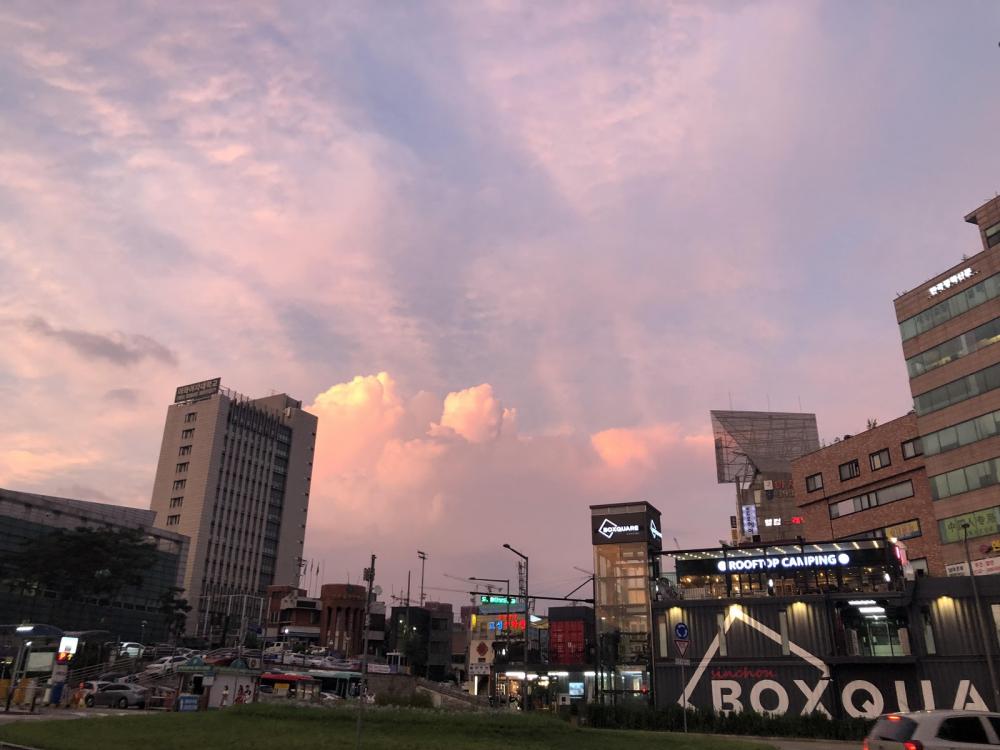 My recommendation for a complimentary artwork is a photograph I took last summer in Seoul. The sunset creates a pink and yellow hue enveloping the city, typical for a warm summer evening. At night, Seoul delivers a "cyberpunk aesthetic" with all of the flashing lights, crowds, and music. Although it wasn't raining on this particular day, if it was raining in the evening, it would have had the same visual effects as in City in the Rain. However, there is similarity in the scale of buildings in each image and although it is not pictured in my photo, there was a subway station on the far left corner that was a perfect reference point to meet friends.
My recommendation for a complimentary artwork is a photograph I took last summer in Seoul. The sunset creates a pink and yellow hue enveloping the city, typical for a warm summer evening. At night, Seoul delivers a "cyberpunk aesthetic" with all of the flashing lights, crowds, and music. Although it wasn't raining on this particular day, if it was raining in the evening, it would have had the same visual effects as in City in the Rain. However, there is similarity in the scale of buildings in each image and although it is not pictured in my photo, there was a subway station on the far left corner that was a perfect reference point to meet friends.
Present Day Dystopia
by Lindsay Burcz '20
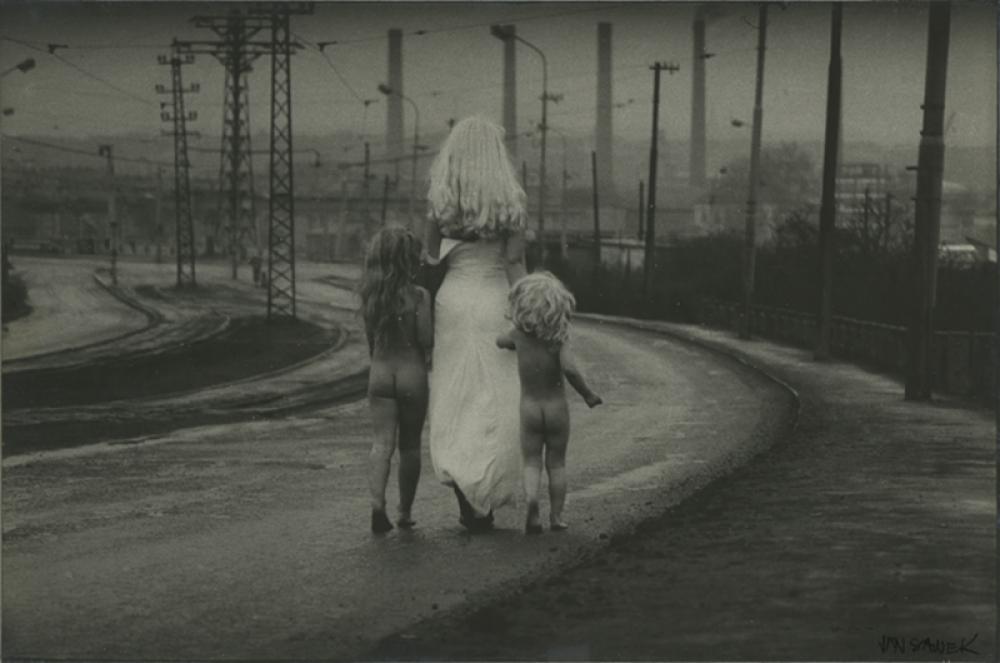 In Fate Descends Towards the River Leading Two Innocent Children by Jan Saudek (Mead Art Museum), a woman clothed in a slightly tattered white dress is walking with two unclothed children down a muddy path. The path is lined by transmission towers and in the distance there is a faint city skyline. The uncertainty and loneliness of the present day is reflected in the children. Although the three figures are standing together, they are isolated from the city that they are walking towards, much like we are while quarantining. The children are seemingly unaware of their destination, holding onto the woman’s hand to guide them into an uncertain future. Their lack of clothing and resources, is reminicent of the situation many find themselves today in our current dystopian-like world.
In Fate Descends Towards the River Leading Two Innocent Children by Jan Saudek (Mead Art Museum), a woman clothed in a slightly tattered white dress is walking with two unclothed children down a muddy path. The path is lined by transmission towers and in the distance there is a faint city skyline. The uncertainty and loneliness of the present day is reflected in the children. Although the three figures are standing together, they are isolated from the city that they are walking towards, much like we are while quarantining. The children are seemingly unaware of their destination, holding onto the woman’s hand to guide them into an uncertain future. Their lack of clothing and resources, is reminicent of the situation many find themselves today in our current dystopian-like world.
 My artwork recommendation is Nocturno by Otto Piene which is part of a larger collection, entitled Fire Paintings, made between 1965 and 2009. Nocturno and Saudek's photograph have many similarities, despite being of two different mediums. The works share a monochromatic color palette that lends a melancholy tone. Both have a white focal point in the center of the composition that draws the eye. Like Saudek’s photograph, Nocturno can be interpreted as a representation of the dystopian conditions created by the current pandemic. The smudge in the middle of the painting is contained by black rings with only little smatterings of white that spread towards the top of the piece, resembling our current patterns of being stuck indoors and leaving only for small errands.
My artwork recommendation is Nocturno by Otto Piene which is part of a larger collection, entitled Fire Paintings, made between 1965 and 2009. Nocturno and Saudek's photograph have many similarities, despite being of two different mediums. The works share a monochromatic color palette that lends a melancholy tone. Both have a white focal point in the center of the composition that draws the eye. Like Saudek’s photograph, Nocturno can be interpreted as a representation of the dystopian conditions created by the current pandemic. The smudge in the middle of the painting is contained by black rings with only little smatterings of white that spread towards the top of the piece, resembling our current patterns of being stuck indoors and leaving only for small errands.
Up Up Up
by Jaey Yim '20
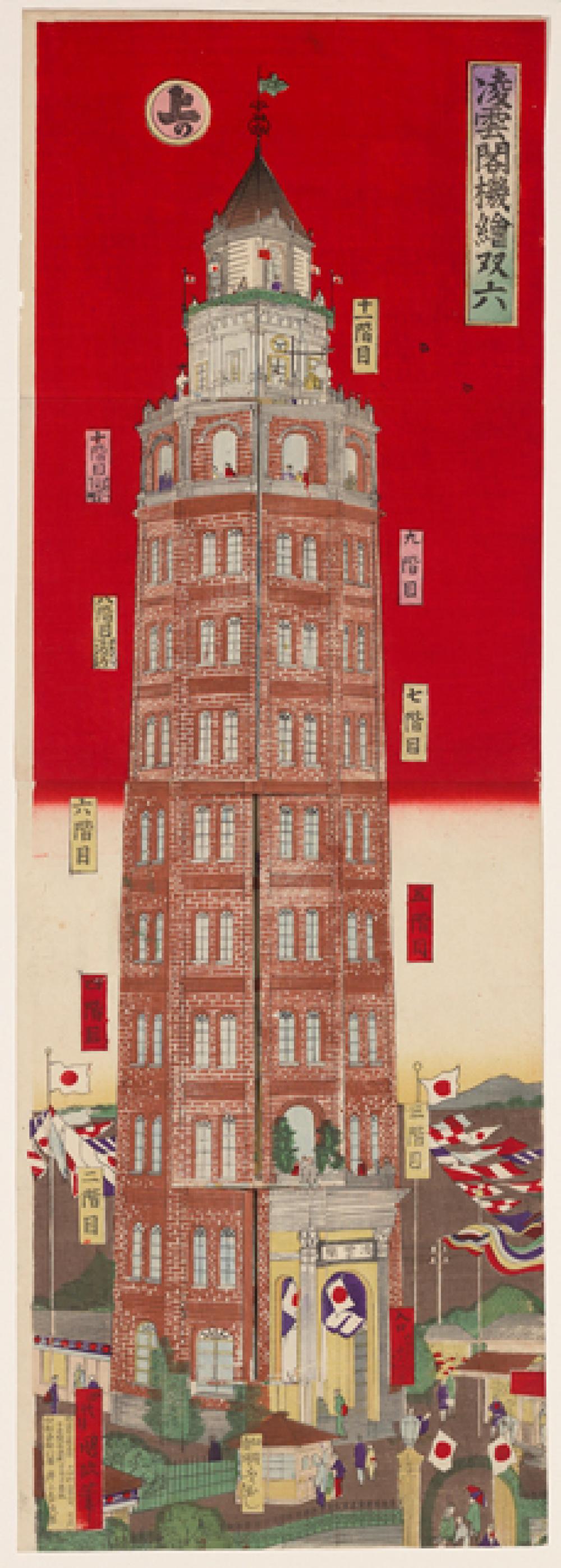 Utagawa Kunimasa IV's woodblock print "Pavilion Above the Clouds" (Ryounkaku kikai sugoroku) (Mead Art Museum), depicts Japan’s first skyscraper which had electric lights on every floor and Japan's first elevator. The second to seventh floors were filled with shops selling imported goods from all around the world. The eighth floor had a musical hall where western concerts were showcased. The tenth to twelfth floors were dedicated to an observatory where one could see the entirety of a new modern Japan forming during the Meiji period—a time where the exchange of trade and ideas with the west molded Japan.
Utagawa Kunimasa IV's woodblock print "Pavilion Above the Clouds" (Ryounkaku kikai sugoroku) (Mead Art Museum), depicts Japan’s first skyscraper which had electric lights on every floor and Japan's first elevator. The second to seventh floors were filled with shops selling imported goods from all around the world. The eighth floor had a musical hall where western concerts were showcased. The tenth to twelfth floors were dedicated to an observatory where one could see the entirety of a new modern Japan forming during the Meiji period—a time where the exchange of trade and ideas with the west molded Japan.
Ryounkaku was touted as a symbol of modernity for tourists and visitors. It was described as a magical structure that continued into the clouds; the Korean name literally means that the building is so high that it exceeds the clouds. For people living in Tokyo, however, Ryounkaku was only slightly taller than their buildings. After many people had visited Ryounkaku and the hype died down, it was referred to instead as Junikai, meaning "twelve steps."
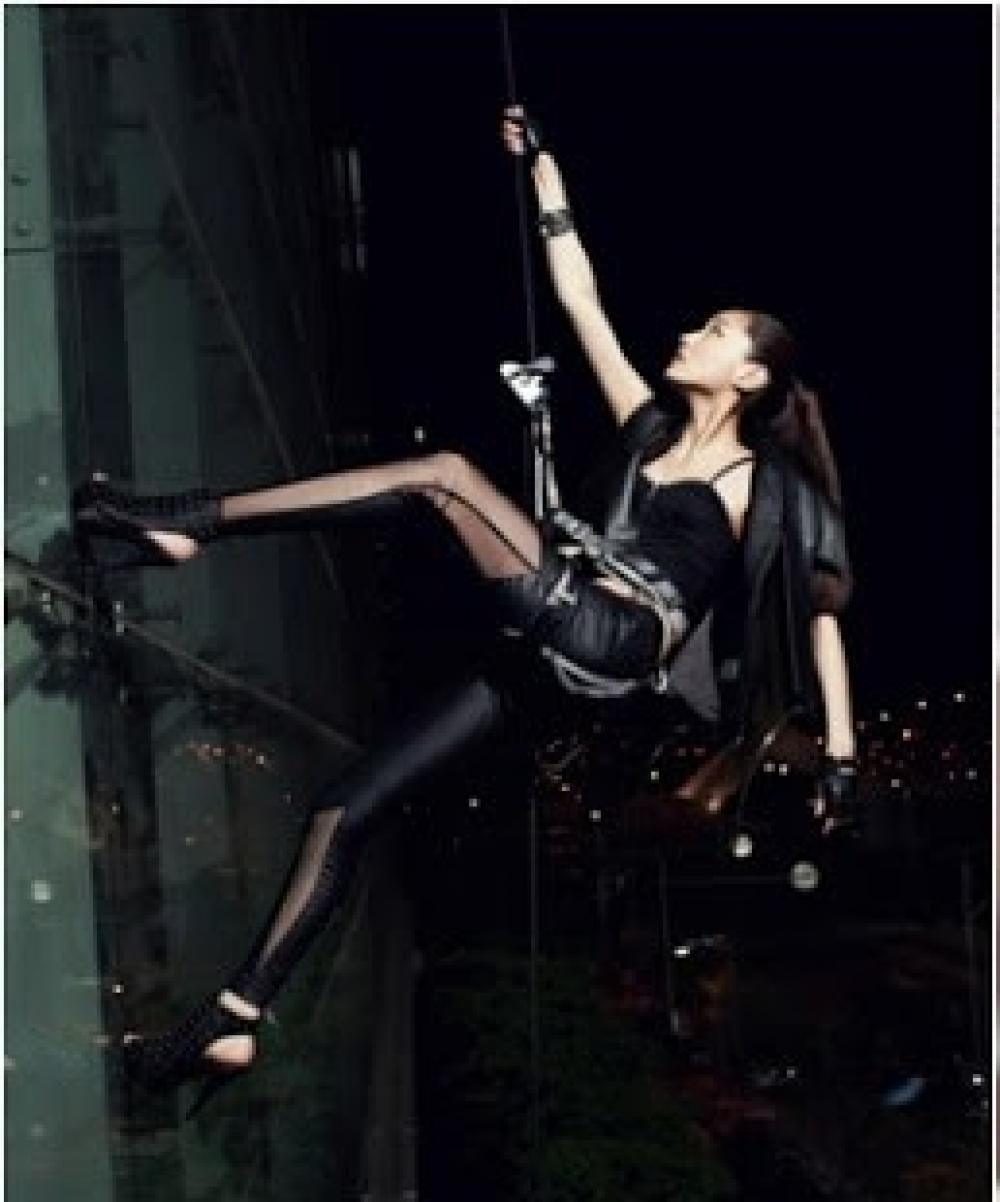 Technology enables us to reach unimaginable heights, which is why I recommend this photograph of a model using cables to stay suspended in the air. This photo makes me think of the elevators in Ryounkaku which employed gears, metal ropes, and pulleys to individually elevate people to higher floors. In the photograph, it looks as though she is climbing the building, which captures the continued desire to ascend to an elevated place while relying on technology.
Technology enables us to reach unimaginable heights, which is why I recommend this photograph of a model using cables to stay suspended in the air. This photo makes me think of the elevators in Ryounkaku which employed gears, metal ropes, and pulleys to individually elevate people to higher floors. In the photograph, it looks as though she is climbing the building, which captures the continued desire to ascend to an elevated place while relying on technology.
Separation Anxieties As Urban Dystopia
by Bethany Powell '22
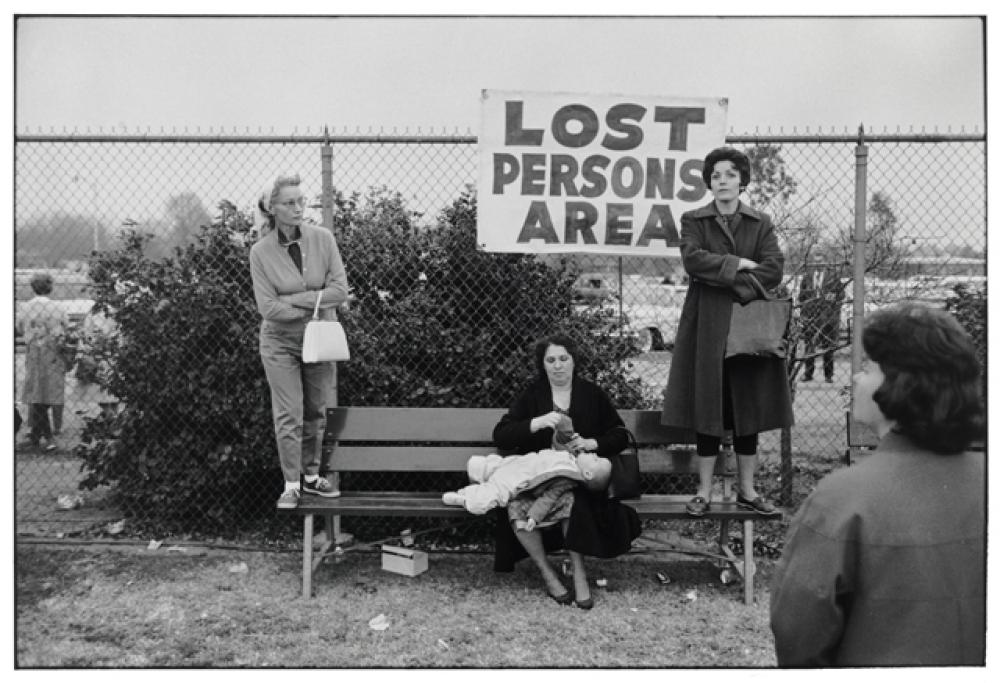 In Elliott Erwitt's photograph Lost Persons/Pasadena, 1963 (Mead Art Museum), a handwritten sign is posted on the chain-link fence that reads "Lost Persons Area.” Underneath it, two women are standing on a bench with postures of frustration or impatience. Between them, a woman sits on the bench holding an infant. There's a feeling of isolation even though they're in close proximity. The lost sense of time and place in this photo comments on the contemporary realities of urban life. As cities become more populated and overdeveloped it's easy to lose one's indivuality or sense of self.
In Elliott Erwitt's photograph Lost Persons/Pasadena, 1963 (Mead Art Museum), a handwritten sign is posted on the chain-link fence that reads "Lost Persons Area.” Underneath it, two women are standing on a bench with postures of frustration or impatience. Between them, a woman sits on the bench holding an infant. There's a feeling of isolation even though they're in close proximity. The lost sense of time and place in this photo comments on the contemporary realities of urban life. As cities become more populated and overdeveloped it's easy to lose one's indivuality or sense of self.
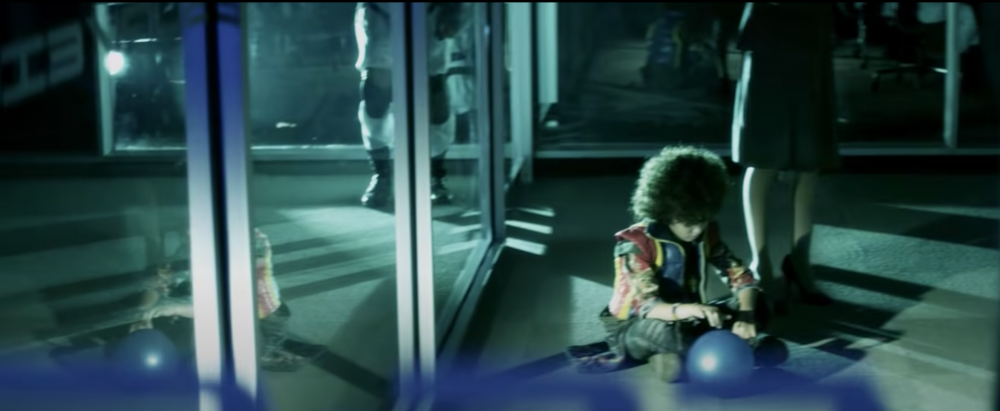 My recommended piece is the music video for the song "Sing" by the rock band My Chemical Romance. In the video, the band of protagonists are leaving the post-apocalyptic wastelands to rescue a child who has been kidnapped by an evil corporation. Dressed in bright clothes, the child contrasts with the sleek corporate environment, and remains curious and playful while the corporate workers wait tensely for the arrival of something sinister. When the child is finally reunited with the chaotic wasteland adventurers, the child's connection to humanity is restored.
My recommended piece is the music video for the song "Sing" by the rock band My Chemical Romance. In the video, the band of protagonists are leaving the post-apocalyptic wastelands to rescue a child who has been kidnapped by an evil corporation. Dressed in bright clothes, the child contrasts with the sleek corporate environment, and remains curious and playful while the corporate workers wait tensely for the arrival of something sinister. When the child is finally reunited with the chaotic wasteland adventurers, the child's connection to humanity is restored.
A special thanks to our Five College Museum partners (the Mead Art Museum at Amherst College, the Smith College Museum of Art, and the University Museum of Contemporary Art at UMass Amherst) as well as Historic Deerfield for access to their remarkable collections, which are represented in this virtual exhibition.

 Give
Give
